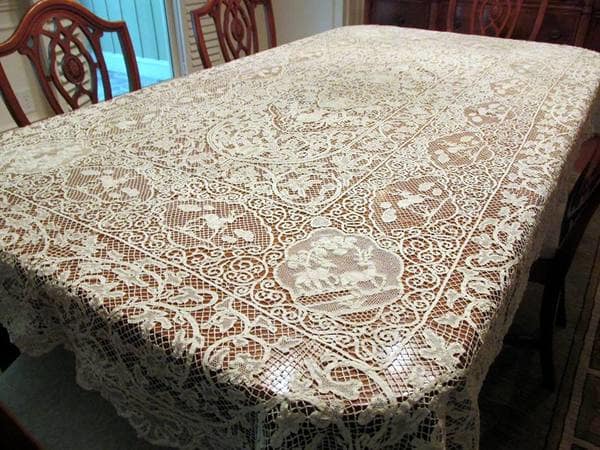Lace is a type of openwork fabric that has deeply rooted history all around the globe. It is categorized generally by fabrication that is independent of a permanent backing material, and is noted for its incredibly delicate intricacies. While there is evidence of the use of lace dating as far back as 2500 B.C. in Egypt, and mention of it in the Bible, lace didn’t really gain momentum and popularity as a fabric of choice until the 14th and 15th centuries in Europe; Belgium is considered the cradle of top quality lace craftsmanship, and Italy also drew the world’s attention to lace through the Catholic Church and Italian court system. Lace became an important indicator of social standing and was often reserved only for the crème de la crème of European communities.
Eventually, however, lace crept its way into the homes and wardrobes of the population, presenting itself frequently in beautiful wedding dresses and home decor. Unfortunately, the Industrial Revolution saw a decrease in handmade lace production, due to the production of machines that could quickly replicate lace patterns without needing the same manpower or time, and production never really returned to its formal glory. Interest in antique lace is rising nowadays and those interested in searching for fine, vintage lace can find stunning pieces that speak volumes about where, when, and for whom it was crafted.

Variations
Needle Lace
Needle lace is just that, lace crafted using only a needle and thread. Sometimes needle lace is started while attached to a piece of fabric or heavy paper, then the threads linking the lace to the backing are cut so just the detailed lace remains.
Bobbin Lace
A bobbin is essentially a spool or reel of thread. This type of lace is made by twisting or braiding many pieces of thread together and then attaching them with pins before securing them to each other or to a separate object (e.g. pillow, cuffs, etc.) with thread. Chantilly lace (usually black or white) is one of the most famous examples of bobbin lace.
Knotted Lace
This type of lace is produced using an instrument called a tatting shuttle, along with involved hand manipulations, to knot the thread and weave it into elaborate patterns.

Collecting
Because lace craftsmanship isn’t as popular today as it once was, collecting antique lace is more of a challenge; the lacking production of top-notch lace drives prices up for collectors, so if you’re looking to start collecting or expand your collection, here are a few things to keep in mind before you dive in!
- Research ahead of time and get familiar with different lace styles and patterns! This will help you in your search, making it easier to recognize the lace you’re looking at, and give you an idea of the quality and whether or not it’s worth the price tag.
- Try to find a reliable lace dealer who, even if you decide not to buy from them, can give you helpful insight about what to look for and where to find it.
- Look everywhere. Apart from dealers, check out estate sales (excellent source if you find someone who collected lace, themselves), garage sales and flea markets. While you might have to sift through a lot of stuff that isn’t great, it’s possible you’ll find some amazing lace that will make it all worth it!
- If it’s not in good condition, don’t buy it. Lace can be very expensive to restore andunless it’s extremely unique and you haven’t seen anything else like itit’s usually not worth the money to have it fixed.

Maintaining And Caring For Your Lace
If you already have a collection going, no matter the size, you might now be wondering how to care for it and keep it in pristine condition. Lace is so delicate and dainty that you want to make sure you treat it with care and don’t do anything that might unintentionally damage it. Below, are some things you should take note of
DO NOT:
-Place in direct sunlight
-Use bleach or harsh chemicals to clean
-Clean in washing machine
-Use home remedies such as salt or lemon juice to spot clean
Hopefully this has given you some insight on how to approach or continue your search for antique lace and just remember: there’s a treasure trove out there, just waiting to tell you its story!
SKM: below-content placeholderWhizzco for DOT

